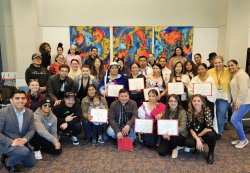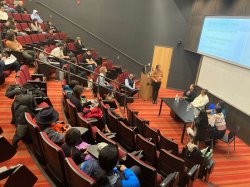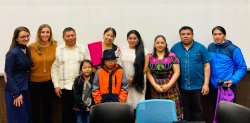Bridging Cultures
Posted in: CLaSE

The class Spanish for Heritage Learners is about much more than proper grammar, spelling and punctuation. To drive that point home, Spanish Language Coordinator Antonella Calarota-Ninman invited members of four different Indigenous groups from Latin American countries to speak to her students. The class watched a film about a Guatemalan Indigenous community before a presentation by the visitors followed by an engaging class discussion.
Hearing from Indigenous groups has “double meaning for students because maybe they’re not directly connected to the community but it’s like their neighbors in their country of origin or their parents or their grandparents,” says Calarota-Ninman, “that’s why I wanted to do it with this class specifically.”
She says the class goes beyond grammar and speech. “It’s building a bridge between who they are here in the United States and their heritage,” she says. “Many of them are born here and may lose contact with their past. So, in the class what I do is try to empower them, helping them understand that their bilingualism and their biculturalism is a gift and it’s precious.”
Rising sophomore Psychology major Andrea Cerna says she enrolled in the class to improve her communication skills. “I wanted to learn how to communicate better in Spanish with my family members,” she says.
Cerna, who is of Peruvian descent, says she learned from Indigenous speakers from Ecuador that the Indigenous languages of the two countries – quechua and Quichua or Kichwa – are quite similar.
She also says she was sad to hear from the group that because they are among the first to live in the U.S., their “whole tradition is not expressed here in the United States and even within the Hispanic community.”
“I found it very impactful,” she says.

Danny Tarifa-Ramirez, a rising junior Film and Television major of Venezuelan descent, says he, too, appreciated the discussion about keeping traditions and culture alive even as Indigenous groups also adapt to societal and technological changes. “They talked about how they have astrological apps for understanding harvests; I think that’s a good way they use technology for the benefit of their communities.”
As a Spanish speaker, Tarifa-Ramirez says he was able to focus on learning linguistics and different Latin American cultures and cultural contexts. “The cultural references and how they vary from country to country, that was definitely important to me.”
As part of the class final, the students produced oral history projects. Cerna interviewed a Peruvian nurse about her career in various countries before her arrival in the U.S. Tarifa-Ramirez interviewed a Guatemalan and Venezuelan musician about “how his culture influenced his artistry and how his music is influenced by his culture.”
The projects are likely to become a part of Hola Montclair State (Historia Oral de los Latinos y Archivo digital), which was launched last year by an interdisciplinary group with faculty from the Spanish and Latino Studies, Sociology, and Teaching and Learning departments. HOLA is “essential to preserve Indigenous cultures, languages and traditions, as well as stories of the Latino communities on campus and in New Jersey,” Calarota-Ninman says.
This collaborative effort began in 2023, when Calarota-Ninman invited a group of 12 Indigenous leaders from the various groups, including Kichwa, Tlapanec, Mije and Mam, to be interviewed by her Spanish 135 students and be part of the oral history project. Calarota-Ninman says the day was very meaningful for her and the students, who learned about the group’s stories, cultures, traditions and struggles.
“I decided to continue the collaboration with these leaders who have a lot to share and to teach,” Calarota-Ninman says. “Informing our community about this collaboration with leaders of different Hispanic Indigenous communities is very important. It will not only awaken interest in those students who are descendants of these groups but also will enrich our community with their knowledge and wonderful culture.”

Story by University Communications Staff Writer Sylvia A. Martinez. Photos courtesy of Antonella Calarota-Ninman.
